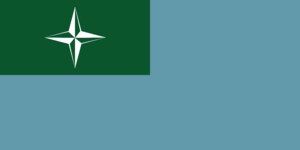Rovaion: Difference between revisions
mNo edit summary |
(Porfiria lore IN OUR TIME) |
||
| Line 45: | Line 45: | ||
'''Rovaīon''' is a Kiravian colony in [[Cusinaut]], occupying a large island directly to the south of the subcontinental mainland, beneath [[Porfíria]]. | '''Rovaīon''' is a Kiravian colony in [[Cusinaut]], occupying a large island directly to the south of the subcontinental mainland, beneath [[Porfíria]]. | ||
The Kiravian presence on Rovaīon dates to 1608 AD. | |||
==History== | |||
The Kiravian presence on Rovaīon dates to 1608 AD. The early exploration and colonisation of Cusinaut by Kiravians was auxiliary to the larger Kiro-Burgundian rivalry for supremacy over the new frontier of oceangoing intercontinental trade. Unable to effectively challenge the Burgundine mercantile network in [[Audonia]], enterprising Kiravians looked to offset this disadvantage by securing better access to the lucrative Alshar trade via an alternative sea route that would bypass the mostly Burgundine-dominated Sea of Istroya by sailing west from the [[Cape Colony]]. | |||
[Actual discovery and initial settlement] | |||
Rovaīon became an important node in the Kiravian overseas trade network, serving as a permanent base for merchants trading with [[Oyashima]], [[Kagoyama]], and [[Metzetta]] (and later [[Corumm]] and [[Tanhai]]), linking ports in these countries to [[Cape Town]] and [[Cities of Kiravia#Sar-i-Pául|Sar-i-Pául]], from whence Alshari wares could pass on to the valuable markets of [[Sarpedon]] or to [[Great Kirav]] itself, and where Kiravian exports (such as whiskey) could be taken on for the return voyage west. The infrastructure required to facilitate such business in Rovaīon and maintain a strong naval presence there to protect the Kiravian merchant marine required more in terms of food and basic materials than was feasible to reliably import from the Cape, and more than local indigenous economies were equipped to provide at scale. This encouraged the development of a colonial primary sector manned by a transplanted productive class of Kiravian farmers, fishermen, and lumberers, and the concomitant formation of a {{wp|settler society}} on Rovaīon and nearby parts of mainland Cusinaut. | |||
[[Category:Kiravian federal subjects]] | [[Category:Kiravian federal subjects]] | ||
Revision as of 14:21, 29 September 2022
| Axerka Rovaīon Colony of Rovaīon | |
 Flag | |
| Country | |
| Theme | |
| Capital | Érskinsar |
| Largest City | Érskinsar |
| Population | 7,866,000 |
| Governor | Dávidus Téniśiron |
| Legislature | Válora |
| Stanora seats | 3 |
| Official languages | Taństan, Kiravic |
| Other Languages | [native languages] |
| Timezone | Offset Cusinaut Time |
| Postal Abbreviation | RVN |
Rovaīon is a Kiravian colony in Cusinaut, occupying a large island directly to the south of the subcontinental mainland, beneath Porfíria.
History
The Kiravian presence on Rovaīon dates to 1608 AD. The early exploration and colonisation of Cusinaut by Kiravians was auxiliary to the larger Kiro-Burgundian rivalry for supremacy over the new frontier of oceangoing intercontinental trade. Unable to effectively challenge the Burgundine mercantile network in Audonia, enterprising Kiravians looked to offset this disadvantage by securing better access to the lucrative Alshar trade via an alternative sea route that would bypass the mostly Burgundine-dominated Sea of Istroya by sailing west from the Cape Colony.
[Actual discovery and initial settlement]
Rovaīon became an important node in the Kiravian overseas trade network, serving as a permanent base for merchants trading with Oyashima, Kagoyama, and Metzetta (and later Corumm and Tanhai), linking ports in these countries to Cape Town and Sar-i-Pául, from whence Alshari wares could pass on to the valuable markets of Sarpedon or to Great Kirav itself, and where Kiravian exports (such as whiskey) could be taken on for the return voyage west. The infrastructure required to facilitate such business in Rovaīon and maintain a strong naval presence there to protect the Kiravian merchant marine required more in terms of food and basic materials than was feasible to reliably import from the Cape, and more than local indigenous economies were equipped to provide at scale. This encouraged the development of a colonial primary sector manned by a transplanted productive class of Kiravian farmers, fishermen, and lumberers, and the concomitant formation of a settler society on Rovaīon and nearby parts of mainland Cusinaut.